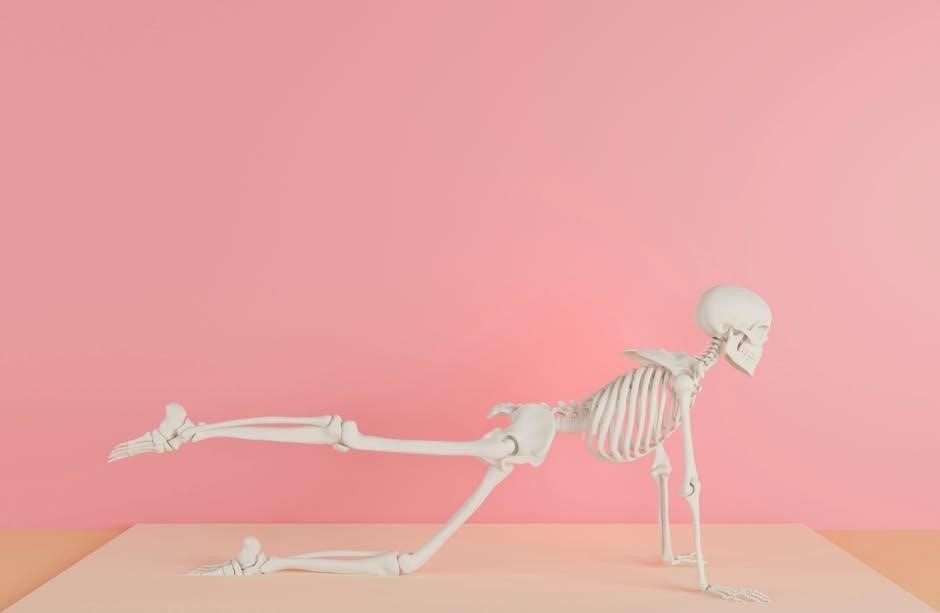Human anatomy explores the structure and organization of the body, revealing how systems interact to maintain life. It combines dissection, imaging, and physiological insights to understand bodily functions and medical applications.
1.1 Definition and Scope of Anatomy
Anatomy is the scientific study of the structure and organization of the human body, focusing on how different parts relate to each other. It involves the examination of both macroscopic (visible to the naked eye) and microscopic (requiring a microscope) details. The scope of anatomy extends from understanding basic body regions to complex systems, using methods like dissection and imaging techniques. This knowledge is essential for medical practice, education, and advancing surgical and therapeutic interventions.
1.2 Importance of Anatomy in Medical Education
Anatomy is foundational in medical education, providing essential knowledge of the human body’s structure and function. It enables healthcare professionals to understand the spatial relationships of organs and tissues, crucial for accurate diagnoses and effective treatments. Anatomy forms the basis for clinical practices, including surgery and imaging, ensuring safe and precise interventions. Mastery of anatomical concepts is vital for developing diagnostic and surgical skills, making it indispensable in healthcare training.
Basic Concepts of Anatomy
Anatomy involves understanding fundamental movements like abduction, adduction, supination, and pronation, which define how body parts move relative to the median plane, essential for medical education and practice.
2.1 Anatomical Movements and Terminology
Anatomical movements include abduction (movement away from the median plane), adduction (toward the median plane), supination (palm facing anteriorly), and pronation (palm facing posteriorly). Eversion (foot sole outward) and inversion (foot sole inward) describe foot movements. These terms form the foundation of anatomical terminology, enabling precise communication about body movements and orientations in medical and educational contexts.

2.2 Planes and Positions in Anatomy
In anatomy, the body is divided into planes: sagittal (divides into left and right), frontal (divides into front and back), and transverse (divides into top and bottom). The anatomical position is the standard reference, with the body upright, arms at the sides, and palms facing forward. These planes and positions provide a universal framework for describing body structures and movements accurately.
Regions of the Human Body
The human body is divided into external and internal regions, each serving specific functions. Key external regions include the cephalic (head), cervical (neck), thoracic (chest), abdominal (belly), and pelvic (hip) areas, while internal regions focus on organs and systems. These regions collectively maintain bodily functions and overall health.
3.1 External and Internal Body Regions
The human body is divided into external and internal regions, each with distinct functions. External regions, such as the cephalic (head), cervical (neck), thoracic (chest), abdominal (belly), and pelvic (hip), are visible and perform specific roles. Internal regions, like the thoracic and abdominal cavities, house vital organs and systems, ensuring bodily functions and overall health. These regions work together to maintain the body’s complex physiological processes effectively.
3.2 Functional Regions and Their Significance
Functional regions of the body are specialized areas that perform specific physiological roles. For example, the cardiothoracic region houses the heart and lungs, essential for circulation and respiration. The abdominal region contains digestive organs, while the pelvic region supports reproductive and urinary functions. Understanding these regions is crucial for diagnosing and treating medical conditions, as dysfunction in one area can impact overall health and bodily systems.
Types of Anatomy
Gross anatomy studies visible body structures, while microscopic anatomy examines tissues and cells. Both are essential for understanding human structure and function, aiding medical diagnosis and research.
4.1 Gross Anatomy and Its Applications
Gross anatomy focuses on the study of body structures visible to the naked eye, providing foundational knowledge for medical education and clinical practices. It aids in understanding spatial relationships between organs and systems, essential for surgeries and diagnostics. Applications include surgical training, anatomical dissection, and educational tools like atlases and models, enhancing medical proficiency and patient care.
4.2 Microscopic Anatomy and Its Importance
Microscopic anatomy examines tissues and cells through magnification, revealing intricate structures and their functions. This field is crucial for understanding cellular processes, diagnosing diseases, and conducting research. Techniques like histology and cytology provide detailed insights, aiding in pathology, pharmacology, and personalized medicine, making it essential for advancing medical knowledge and treatment development.

Key Concepts in Anatomy Education
Anatomy education focuses on foundational knowledge of body structures, enabling healthcare professionals to understand function and diagnose effectively, linking anatomical concepts to clinical practice and patient care.
5.1 Learning Objectives for Anatomy Courses
Anatomy courses aim to equip students with a comprehensive understanding of human body structures, their relationships, and functions. Key objectives include identifying anatomical landmarks, understanding directional terminology, and correlating structure with function. Students also learn to interpret imaging techniques and apply anatomical knowledge to clinical scenarios, preparing them for careers in healthcare and related fields effectively.
5;2 Essential Tools for Studying Anatomy
Effective anatomy study requires a combination of tools and resources. Anatomical atlases with detailed illustrations, such as Grants Atlas, provide visual insights. Virtual dissection software and 3D models enhance understanding. Flashcards help memorize terminology, while lecture notes and textbooks offer structured knowledge. Additionally, imaging techniques like MRI and CT scans allow practical application, making these tools indispensable for mastering human anatomy.
Modern Imaging Techniques in Anatomy
Modern imaging techniques like MRI, CT scans, and X-rays revolutionize anatomy education and diagnostics, offering detailed, non-invasive views of internal structures, enhancing both learning and clinical applications significantly.
6.1 Role of Imaging in Anatomy Education
Imaging technologies play a pivotal role in anatomy education by providing detailed, three-dimensional views of internal structures. Tools like MRI, CT scans, and X-rays enhance traditional dissection methods, allowing students to visualize complex anatomical relationships. These technologies also enable interactive learning, making abstract concepts more tangible. Incorporating imaging fosters a deeper understanding of human anatomy, bridging the gap between theoretical knowledge and practical application in medical training. Additionally, they aid in identifying variations and abnormalities, preparing future healthcare professionals for real-world scenarios.
6.2 Advances in Diagnostic Anatomy
Modern diagnostic anatomy leverages cutting-edge imaging techniques to enhance accuracy and precision in clinical settings. Innovations like 3D reconstruction, virtual dissection, and artificial intelligence improve the visualization and interpretation of anatomical structures. These advancements enable early detection of abnormalities, facilitate personalized treatment plans, and reduce diagnostic errors. They also support minimally invasive procedures, revolutionizing healthcare by integrating anatomy with advanced diagnostic tools for better patient outcomes and streamlined medical practices.

Historical Development of Anatomy
Anatomy’s evolution began with ancient dissections, advancing through centuries with detailed observations and imaging techniques, shaping our understanding of the human body’s structure and functions.
7.1 Evolution of Anatomical Knowledge
The evolution of anatomical knowledge began with ancient dissections and detailed observations, progressing through centuries with advancements in imaging techniques. Early anatomists like Galen and Vesalius laid the foundation, while modern technologies such as MRI and CT scans have further enhanced our understanding of the human body’s structure and functions, continuously refining anatomical studies and their applications in medicine.
7.2 Contributions of Key Anatomists
Key anatomists like Vesalius, Leonardo da Vinci, and Galen revolutionized the field by correcting historical errors and providing detailed insights. Vesalius’s accurate human dissections and da Vinci’s anatomical illustrations set new standards. Galen’s early work, though later refined, laid foundational knowledge. Their contributions have shaped modern anatomy, enabling precise understanding of the human body for medical education and practice.

Applications of Anatomy in Healthcare
Anatomy is crucial for understanding body structure, enabling accurate diagnostics, targeted treatments, and surgical precision. It aids in interpreting imaging, guiding interventions, and enhancing interprofessional communication in patient care.
8.1 Clinical Anatomy and Its Relevance
Clinical anatomy applies anatomical knowledge to diagnose and treat diseases. It bridges basic science and practical medicine, enhancing imaging interpretation, surgical planning, and patient outcomes. Understanding normal and variant anatomy is vital for accurate diagnoses and effective treatments, making it indispensable in modern healthcare.
8.2 Surgical Anatomy and Its Importance
Surgical anatomy focuses on detailed anatomical knowledge crucial for operative procedures. It emphasizes spatial relationships, landmarks, and variations, enabling precise dissection and minimizing complications. This specialized field directly impacts surgical success, patient safety, and recovery outcomes, making it a cornerstone of modern surgical practice and medical training.

Anatomical Systems and Their Interrelations
The human body comprises interconnected systems functioning collectively to maintain life. These systems, such as skeletal, muscular, nervous, and circulatory, coordinate to enable movement, sensation, and overall bodily harmony.
9.1 Skeletal and Muscular Systems
The skeletal system, comprising bones, joints, and ligaments, provides structural support and protection. The muscular system, including voluntary and involuntary muscles, facilitates movement and maintains posture. Together, they enable locomotion, stabilize the body, and contribute to overall physiological functions, forming a harmonious interplay essential for human movement and stability.
9.2 Nervous and Circulatory Systems
The nervous system, comprising the brain, spinal cord, and nerves, controls bodily functions, enabling communication and response to stimuli. The circulatory system, including the heart, blood vessels, and blood, transports oxygen and nutrients to cells. These systems interconnect, with the nervous system regulating circulatory functions, ensuring efficient delivery of resources and maintenance of homeostasis, crucial for overall health and bodily operations.

Anatomical Variations and Anomalies
Anatomical variations are normal differences in body structure, while anomalies are abnormal deviations. Recognizing these is crucial for accurate diagnoses and personalized medical treatment plans.
10.1 Understanding Normal and Abnormal Anatomy
Normal anatomy refers to the typical structure of body parts, while abnormal anatomy involves deviations like congenital defects or pathologies. Recognizing these distinctions is vital for diagnosis, treatment, and understanding human variation. Abnormalities can result from genetic factors, environmental influences, or acquired conditions, impacting function and health outcomes. This knowledge aids in developing personalized medical approaches and improving patient care.
10.2 Implications for Medical Practice
Understanding normal and abnormal anatomy is crucial for accurate diagnoses and effective treatments. Variations and anomalies inform surgical planning, ensuring procedures are tailored to individual needs. This knowledge also enhances diagnostic imaging interpretation and personalized medicine approaches. Recognizing anatomical differences improves patient outcomes by enabling targeted interventions and reducing complications, making it foundational for modern medical practice and decision-making.

Future Trends in Anatomy Education
Future trends include integrating advanced technologies like AI, VR, and 3D modeling to enhance learning experiences. These tools enable interactive, personalized education, making anatomy more accessible and engaging for students.
11.1 Integration of Technology in Anatomy
Technology is transforming anatomy education through virtual dissection tools, 3D simulations, and interactive models. These resources provide immersive learning experiences, allowing students to explore complex structures in detail. AI-driven platforms also offer personalized learning paths, enhancing engagement and understanding. This integration not only modernizes traditional teaching methods but also ensures anatomy education remains relevant and effective in the digital age.
11.2 Emerging Concepts in Anatomical Science
Emerging concepts in anatomy include advanced imaging techniques and microscopic discoveries. These innovations reveal intricate details of cellular structures and tissue interactions. Modern research focuses on understanding anatomical variations and their implications for personalized medicine. Such advancements are reshaping the field, offering new insights into human anatomy and its role in health and disease.
Anatomy remains a cornerstone of medical education, continually evolving with technological advancements; Its study bridges structure and function, essential for understanding human health and advancing medical practices globally.
12.1 Summary of Key Anatomical Concepts
Anatomy is the study of body structures, emphasizing their relationships and functions. Key concepts include anatomical movements, planes, and positions, as well as the organization of body systems. Understanding these principles is crucial for medical education and practice, providing a foundation for diagnosing and treating conditions. These concepts are essential for comprehending human physiology and maintaining overall health.
12.2 The Ever-Evolving Field of Anatomy
Anatomy remains a dynamic discipline, continually advancing with technological innovations. Modern imaging techniques and integrative studies expand our understanding of human structures. Emerging concepts and interdisciplinary approaches ensure anatomy’s relevance in medical education and practice, driving progress in healthcare and research. This evolution underscores anatomy’s vital role in addressing future challenges and improving patient outcomes.

